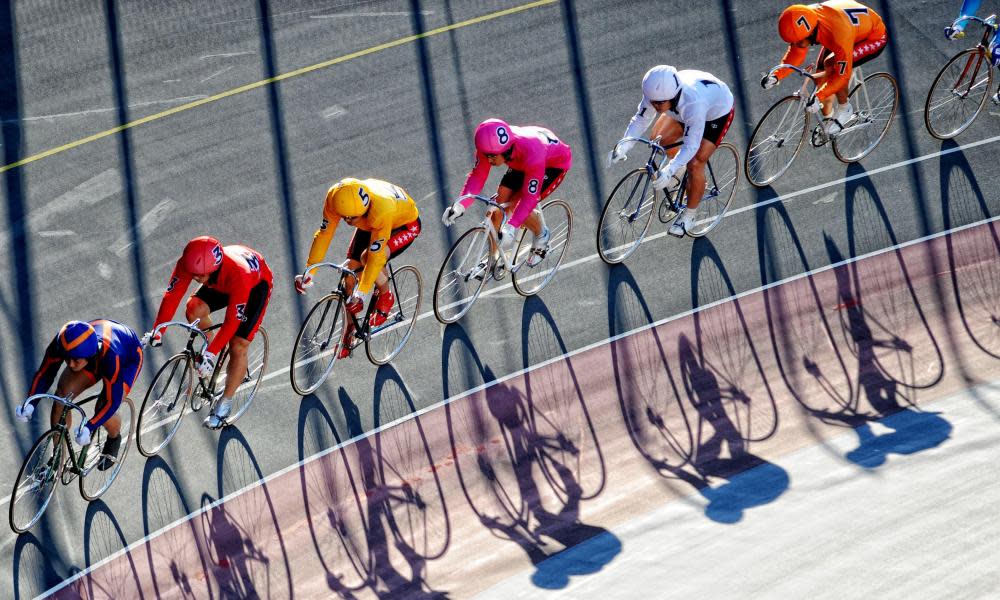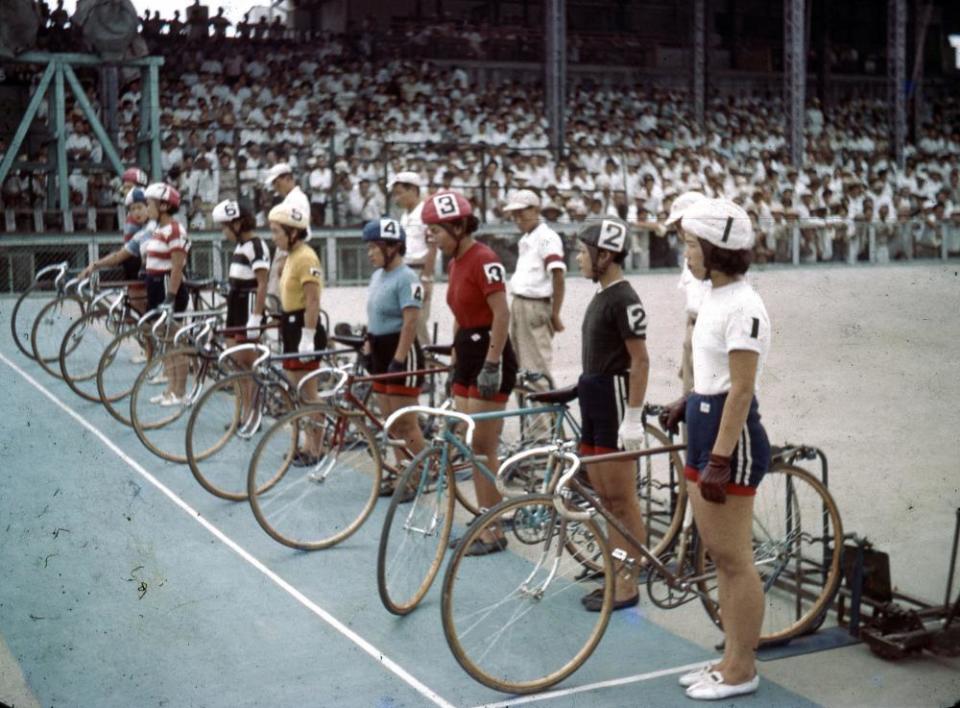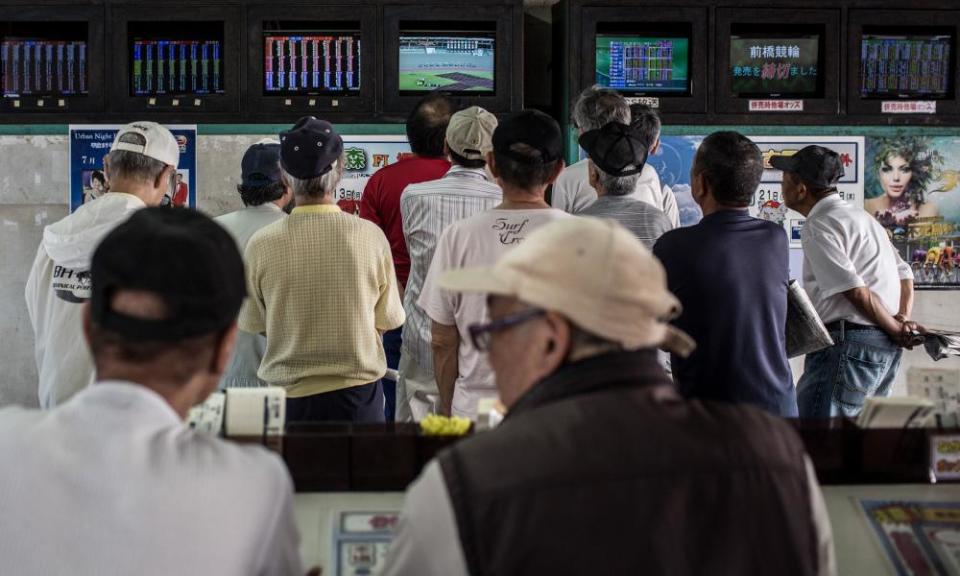Why I love keirin – one of the most exciting events in any Olympics

“Whatever you do, don’t stop pedalling or you’ll be thrown off the bike.”
That was the final piece of advice Ryo Okuhara gave me as, with a gentle push, he sent me on a gingerly paced lap of a velodrome on a steel-framed bicycle with no brakes, my feet strapped into pedals that never stopped turning.
I had pootled around an indoor wooden track a couple of years earlier, but this was my first outing on one of the vast “banks” familiar to fans of keirin – a track cycling event invented in Japan after the second world war.
Related: Tour de France 2021: stage-by-stage guide | William Fotheringham
The object of the exercise was to stay upright on the steep slopes at either end of the 400m track, before swooping down on to kinder, flatter surfaces in the home and back straights.
Having written a book in about the history and culture of keirin, it seemed only natural, if a little reckless, to gauge if anything I had learned could see me safely around the forbidding gradients of Kawasaki’s concrete surface.
I was a relative keirin novice when James Spackman, the founder of Pursuit Books, a London-based cycling imprint, suggested telling the story of the sport’s transformation from entertainment for Japan’s war-weary masses to an Olympic event that has made stars of British cyclists Chris Hoy, Victoria Pendleton and Jason Kenny.
Initially held to raise taxes on gambling to fund Japan’s postwar reconstruction, keirin now generates billions of dollars in sales, with the best riders earning millions.
The rules are simple enough. In a typical men’s race, a pacemaker leads nine cyclists around several laps before leaving them to battle it out. Along the way they clash heads - and sometimes crash - as they reach speeds of up to 70 kph in the final stretch.
My research began with a trip to Kokura, an industrial port city in Japan’s south-west, to uncover the origins of the country’s most important contribution to track cycling, but for which, I would discover, most people – even those connected to the sport – seemed compelled to apologise.
Kokura, which had escaped nuclear annihilation but not heavy conventional bombing, hosted the world’s first keirin race on 20 November 1948. Over four days, more than 50,000 people, mostly working-class men who had been in military uniform a few years earlier, watched hastily assembled lineups of amateur men and women compete on a vast outdoor track.

More than 70 years later, keirin continues to occupy an uneasy place in the Japanese sporting firmament because of its association with gambling. As one of only four sports – along with horses, motorboats and a form of speedway – on which it is legal to wager money in Japan, keirin has spent much of its history battling to defend its reputation. The year-end grand prix – with a million-dollar prize at stake – is one of the few occasions when the sport attracts the attention of the public broadcaster NHK and reports appear in broadsheet newspapers as well as sport tabloids.
By the end of the meet in Kokura, spectators had gambled unimaginable sums, a portion of which went on the city’s postwar redevelopment, as intended by the sport’s founders. Suburban velodromes sprouted up in dozens of other Japanese towns and cities, as moral objections to gambling were temporarily set aside amid the rush to raise desperately needed revenue.

Keirin’s early years were marred by race-fixing scandals and the involvement of the yakuza, Japan’s crime syndicates. Velodromes could be violent, unwelcoming places, where the mere suspicion that a rider had given anything less than 100% sparked unrest among well-oiled, mostly male punters.
But Japanese officialdom’s squeamishness towards gambling is only part of keirin’s story.
The history of keirin is bound up in Japan’s postwar development. Its chaotic origins reflected the turmoil of the postwar years, yet it was to survive political assaults and thrive during a time of rising incomes and Japan’s economic transformation, before the bursting of the country’s asset-inflated bubble plunged it into its own version of the “lost decade”, in the early 1990s.
Over several months, I travelled from Fukushima in the north to Fukuoka in the south to watch races and interview an eclectic cast of keirin characters: up-and coming riders and journeymen in their late 40s; veteran frame builders and historians, journalists and coaches, and, of course, the men – and a much smaller number of women – who enjoy a flutter on the bikes. I watched prospective cyclists being put through their paces during 11 gruelling months at a training school near Mount Fuji, and spent a shochu-fuelled evening with Koichi Nakano, a keirin legend and one of the greatest track cyclists of all time.
Keirin has weathered storms throughout its history. Today, it still generates billions of dollars in betting receipts and, in setting aside cash for public services and infrastructure, has stayed true to its philanthropic origins.

Even so, it was surprising how few Japanese friends greeted the news that I was taking unpaid leave to write a book about keirin with genuine enthusiasm. Most thought I had taken leave of my senses. Some confessed they had no idea what I was talking about.
That is partly why War On Wheels became a book not about cycling, but about Japan, viewed through the prism of its exhilarating cycling subculture. A blue-collar Japan “hidden” from the rest of the world for the best part of a century, centred on a community of sportsmen and women who ply their trade in the shadows.
I completed the manuscript convinced that to broaden its appeal and last another 70 years, keirin must open up to the rest of the world, beyond the biennial competitions between professional riders from Japan and South Korea, the only other country with a professional circuit. And much more could be done to promote the women’s sport, starting with a name change.
Keirin continues to make demands on my time and finances. I am hooked on the speed and physicality, and follow the fortunes of my favourite riders online, in the tabloid press and on social media. I read keirin manga and books, and seek out references, however brief, in films and on TV.

What began as a modest collection of keirin paraphernalia – towels, jerseys, mugs, keyrings – now fills a stack of plastic drawers. Slips of paper revealing unsuccessful bets that should have been discarded in disgust fill a shoebox; a keirin frame I ride around Tokyo – with brakes – takes pride of place in my apartment.
The same obsession had brought me to Kawasaki velodrome for my meeting with Okuhara, a professional racer who kindly slowed down as he waved his novice companion through to complete the final lap, which ended with bicycle and rider intact.
Related: Mark Cavendish back at Tour de France for first time since 2018
It was a far cry from Izu velodrome, where in just a few weeks Japanese riders will take time away from professional meets to compete in the keirin at the 2020 Olympics.
A Japanese medal of any colour would boost the sport’s profile in the country of its birth. But even if the host nation’s riders fail to bring keirin full circle in Tokyo this summer, the newly crowned Olympic champion should join cycling fans in pausing to thank the forgotten men and women on bikes who lined up in a war-torn Japanese city 73 years ago.
Justin McCurry’s book, War on Wheels: Inside Keirin and Japan’s Cycling Subculture, will be published on 24 June by Pursuit Books.

 Yahoo Movies
Yahoo Movies 
